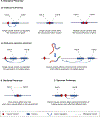Pleiotropy and Cross-Disorder Genetics Among Psychiatric Disorders
- PMID: 33131714
- PMCID: PMC7898275
- DOI: 10.1016/j.biopsych.2020.09.026
Pleiotropy and Cross-Disorder Genetics Among Psychiatric Disorders
Abstract
Genome-wide analyses of common and rare genetic variations have documented the heritability of major psychiatric disorders, established their highly polygenic genetic architecture, and identified hundreds of contributing variants. In recent years, these studies have illuminated another key feature of the genetic basis of psychiatric disorders: the important role and pervasive nature of pleiotropy. It is now clear that a substantial fraction of genetic influences on psychopathology transcend clinical diagnostic boundaries. In this review, we summarize evidence in psychiatry for pleiotropy at multiple levels of analysis: from overall genome-wide correlation to biological pathways and down to the level of individual loci. We examine underlying mechanisms of observed pleiotropy, including genetic effects on neurodevelopment, diverse actions of regulatory elements, mediated effects, and spurious associations of genomic variation with multiple phenotypes. We conclude with an exploration of the implications of pleiotropy for understanding the genetic basis of psychiatric disorders, informing nosology, and advancing the aims of precision psychiatry and genomic medicine.
Keywords: Cross-disorder; GWAS; Genetic correlation; Nosology; Pleiotropy; Precision psychiatry; Psychiatric genetics.
Copyright © 2020 Society of Biological Psychiatry. Published by Elsevier Inc. All rights reserved.
Figures



Similar articles
-
Genomic Relationships, Novel Loci, and Pleiotropic Mechanisms across Eight Psychiatric Disorders.Cell. 2019 Dec 12;179(7):1469-1482.e11. doi: 10.1016/j.cell.2019.11.020. Cell. 2019. PMID: 31835028 Free PMC article.
-
A comprehensive gene-centric pleiotropic association analysis for 14 psychiatric disorders with GWAS summary statistics.BMC Med. 2021 Dec 13;19(1):314. doi: 10.1186/s12916-021-02186-z. BMC Med. 2021. PMID: 34895209 Free PMC article.
-
Examining the shared etiology of psychopathology with genome-wide association studies.Physiol Rev. 2023 Apr 1;103(2):1645-1665. doi: 10.1152/physrev.00016.2022. Epub 2023 Jan 12. Physiol Rev. 2023. PMID: 36634217 Free PMC article. Review.
-
[New directions in psychiatric genetics: Genome-wide association studies, polygenic risk score and cross-disorder analysis].Psychiatr Hung. 2019;34(4):411-418. Psychiatr Hung. 2019. PMID: 31767801 Review. Hungarian.
-
Disorders and borders: psychiatric genetics and nosology.Am J Med Genet B Neuropsychiatr Genet. 2013 Oct;162B(7):559-78. doi: 10.1002/ajmg.b.32174. Am J Med Genet B Neuropsychiatr Genet. 2013. PMID: 24132891 Review.
Cited by
-
An integrated clinical approach to children at genetic risk for neurodevelopmental and psychiatric conditions: interdisciplinary collaboration and research infrastructure.J Neurodev Disord. 2024 Jul 5;16(1):37. doi: 10.1186/s11689-024-09552-x. J Neurodev Disord. 2024. PMID: 38970057 Free PMC article.
-
Transcriptional profiles in the mouse amygdala after a cognitive judgment bias test largely depend on the genotype.Front Mol Neurosci. 2022 Oct 24;15:1025389. doi: 10.3389/fnmol.2022.1025389. eCollection 2022. Front Mol Neurosci. 2022. PMID: 36533130 Free PMC article.
-
Global Impacts of Western Diet and Its Effects on Metabolism and Health: A Narrative Review.Nutrients. 2023 Jun 14;15(12):2749. doi: 10.3390/nu15122749. Nutrients. 2023. PMID: 37375654 Free PMC article. Review.
-
Genomic structural equation modeling reveals latent phenotypes in the human cortex with distinct genetic architecture.Transl Psychiatry. 2024 Oct 24;14(1):451. doi: 10.1038/s41398-024-03152-y. Transl Psychiatry. 2024. PMID: 39448598 Free PMC article.
-
Comparison of the multivariate genetic architecture of eight major psychiatric disorders across sex.Nat Genet. 2025 Mar;57(3):583-590. doi: 10.1038/s41588-025-02093-6. Epub 2025 Mar 7. Nat Genet. 2025. PMID: 40055480 Free PMC article.
References
-
- Smoller JW (2013): Disorders and borders: psychiatric genetics and nosology. Am J Med Genet B Neuropsychiatr Genet. 162B:559–578. - PubMed
-
- Watanabe K, Stringer S, Frei O, Umicevic Mirkov M, de Leeuw C, Polderman TJC, et al. (2019): A global overview of pleiotropy and genetic architecture in complex traits. Nat Genet. 51:1339–1348. - PubMed
Publication types
MeSH terms
Grants and funding
LinkOut - more resources
Full Text Sources
Other Literature Sources
Medical

